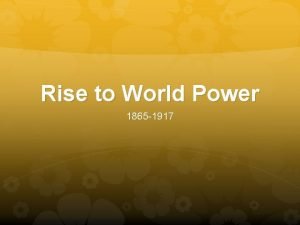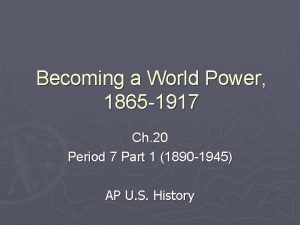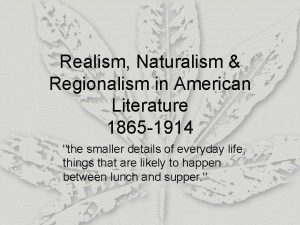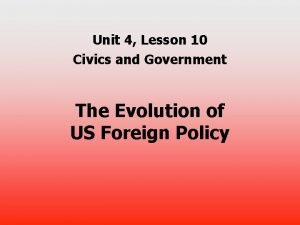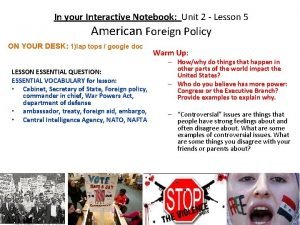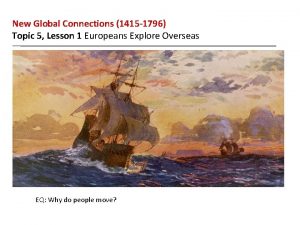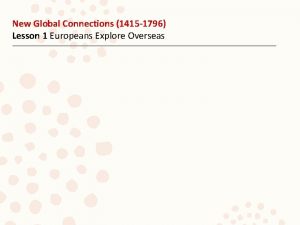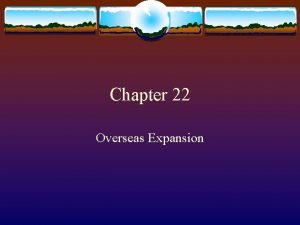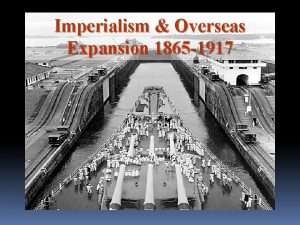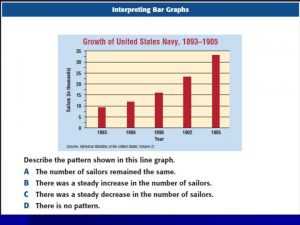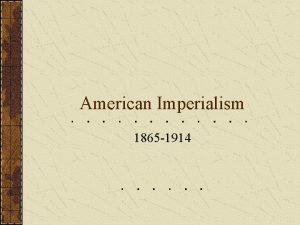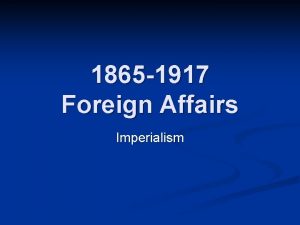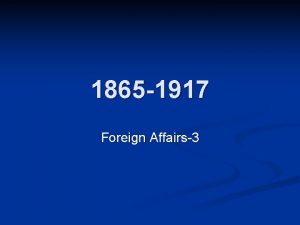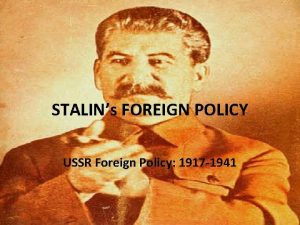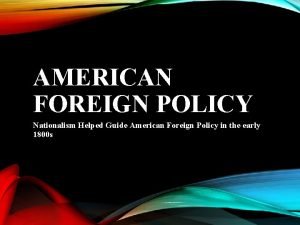Overseas Expansion 1865 1917 Expanding Horizons American Foreign














- Slides: 14

Overseas Expansion 1865 -1917

Expanding Horizons § American Foreign Policy 1. Before the Civil War, the U. S. practiced isolationism or noninvolvement in world affairs 2. After the Civil War, the U. S. changed it’s policy to expansionism or a belief in expanding the nation’s boundaries

Imperialism § The late 1800 s and early 1900 s were called an age of imperialism. § Imperialism can be described as a nation’s policy of increasing its power by gaining political, economic, or territorial control of other areas. § The U. S. became interested in overseas expansion at the end of the 1800 s due to the growth of American industry. § European countries and the U. S. became imperialistic due to the desire for new overseas markets, the need for new sources of raw materials, and a belief that European culture was superior.

Examples of American Imperialism § § § Japan – In 1853, Pres. Fillmore sent Commodore Matthew Perry on a mission to Japan. His purpose was to open Japan to American trade. Both sides agreed and signed the Treaty of Kanagawa in 1854. This marked the start of greater American involvement in Asia

• Alaska – In 1867, under the direction of William Seward, the U. S. purchased Alaska from Russia. It was known as “Seward’s Folly” and a “polar bear garden” but soon Alaska proved to be beneficial as it provided the U. S. with lumber, gold, and oil.

• Hawaii – Hawaii was annexed due to the encouragement of American sugar plantation owners that had been in Hawaii since the 1830 s. • The Hawaiian queen, Liliuokalani, tried to preserve her land’s independence. However, John Stevens, the American diplomat in Hawaii, arranged for U. S. marines from the warship Boston to assist in an uprising which resulted in overthrowing Queen Liliuokalani. • Hawaii was officially annexed in 1898.

• American Samoa – In 1899, the U. S. , Great Britain, and Germany met in Berlin to discuss the islands of Samoa. Through diplomatic negotiation, the U. S. acquired their part of the Samoan Islands. • China and the Open Door Policy– By the late 1890 s, Japan and other leading European nations had carved out spheres of influence or areas where trading rights were given to foreign powers in China. • The U. S. worried about being squeezed out of the profitable China trade. Therefore Sec. of State John Hay proposed an open door policy which would allow each foreign nation in China to trade freely in other nation’s sphere of influence.

• The open door policy was accepted by the other nations after the Boxer Rebellion. • The Boxer Rebellion was a famous uprising by the Chinese against Western foreigners in China in 1900.

The Spanish American War Causes – 1. Protection of American business interests in Cuba 2. American support of Cuban rebels to gain independence from Spain 3. Rising tensions as a result of the sinking of the U. S. S. Maine in Havana Harbor. This was the immediate cause of the Spanish-American War. 4. Exaggerated news reports of events in Cuba (yellow journalism – used by Joseph Pulitzer and William Randolph Hearst)

Results – 1. The U. S. emerged as a world power 2. Cuba gained independence from Spain 3. The U. S. gained possession of Spanish-held islands in the Pacific and the Caribbean as colonies. These included Guam, Puerto Rico, and the Philippines. The U. S. paid $20 million for the Philippines. 4. After the U. S. gained possession of the Philippines, the Filipinos began a revolt against American rule led by Emilio Aguinaldo

The Panama Canal • Americans and Europeans had dreamed of building a canal across Central America to connect the Atlantic and Pacific Oceans and to eliminate the long and dangerous voyage around South America. • Panama was a province of Colombia. In 1903 the U. S. negotiated treaty with Colombia that would allow a canal to built in Panama. However, the treaty was rejected. • Therefore Pres. Theodore Roosevelt, who was influential in building the Panama Canal, encouraged and supported a revolt in Panama which would lead to their independence.

• With Panama now independent, the U. S. could now start constructing the canal. However, it was not easy as the workers had to combat diseases such as malaria and yellow fever. Workers also had to cut a path through dense jungle and over mountains. • The Panama Canal was opened on August 15 th, 1914.

Theodore Roosevelt and Latin America § Often used the quote “speak softly and carry a big stick” when dealing with foreign affairs in Latin America. He meant that the U. S. should not threaten other nations, but show the strength of your military power. § Roosevelt was concerned that instability in the Caribbean region would lead to European nations to intervene. § He came up with the Roosevelt Corollary, which claimed that the U. S. had the right to intervene in the affairs of Latin American nations wherever those nations seemed unstable and law and order was threatened.

William Howard Taft and Latin America § Whereas Roosevelt thought of American power mostly in military terms, Taft had a different approach. § He “substituted dollars for bullets” or dollar diplomacy. § Taft believed American investments would provide stability to troubled areas of the world as well as profit and power to the U. S. § American investments helped build roads, railroads, and harbors which stimulated trade and brought benefits to both Latin America and the U. S.
 Becoming a world power 1865-1917
Becoming a world power 1865-1917 Becoming a world power 1865-1917
Becoming a world power 1865-1917 Realism and regionalism in american literature
Realism and regionalism in american literature Too foreign for home
Too foreign for home Unit 4 lesson 10 american foreign policy
Unit 4 lesson 10 american foreign policy Lesson 5: american foreign policy
Lesson 5: american foreign policy Zip trading overseas ab
Zip trading overseas ab New global connections unit test
New global connections unit test Monash semester abroad
Monash semester abroad Cdc jobs overseas
Cdc jobs overseas Suss graduation requirements
Suss graduation requirements Lesson 1 europeans explore overseas
Lesson 1 europeans explore overseas Lesson 1: europeans explore overseas
Lesson 1: europeans explore overseas Ktk overseas ag
Ktk overseas ag American international school rome
American international school rome
